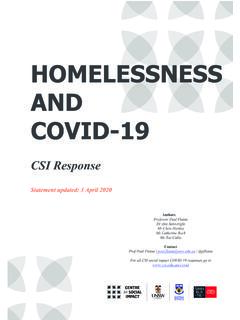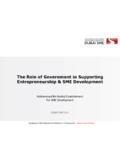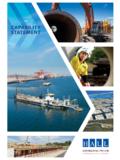Transcription of Demolishing gender structures - Home | CSI
1 Demolishing gender structuresNever Stand StillBuilt Environment, Arts & Social Sciences and Centre for Social ImpactThe construction industry is the most male-dominated sector in Australia: in 2016 women represent only 12% of the workforce, a decrease from 17% in 2006 (ABS 2016, ABS 2006). Among professional and managerial roles, women represent 14% of staff (ABS 2012). Men dominate senior technical , operational careers, while women congregate in junior, support roles and non-fee-earning professions such as human resources and marketing.
2 Early enthusiasm by women about construction professions and their future careers in the sector decreases with increased exposure to the workplace as they experience relative disadvantage and inequality in pay, development and promotional opportunities compared to their male counterparts (Dainty et al., 2000). These experiences take their toll with women leaving the construction professions almost 39% faster than their male colleagues (APESMA, 2010).This briefing summarises findings from a recent study by Natalie Galea, Adam Rogan, Abigail Powell, Louise Chappell and Martin Loosemore.
3 It investigates why existing formal policies and strategies to attract, retain and support the progression of women professionals in large construction companies have failed to achieve gender equality and research showed that construction companies are actively piloting a range of initiatives to support gender diversity for example flexibility initiatives, wellbeing initiatives and gender targets. During the time of the research, the companies made strides in addressing the gender pay gap. Companies also offer a suite of policies to support gender diversity including, childcare rebate provisions and paid parental leave.
4 Construction has come a long way, RecruitmentDifferent recruitment channels: Informal networks influence formal recruitment processes. They provide a way for applicants to get a foot in the door and secure an employment position. Women are more likely to be recruited through formal recruitment channels and men are more likely to gain access through informal networks. Focus on the pipeline and cultural fit: There is a strong focus of recruiting from the traditional education pipeline and for candidates to be a cultural fit within a company, with little reflection as to what this means.
5 This limits diversity of candidates. Recommendations: Make company and project recruitment processes and criteria more transparent. Review the values that underpin cultural fit to determine if they are gendered and exclusionary. Initiate recruitment drives specific to women not from the traditional pipeline and provide these recruits with construction training. Male sponsorship: Recruitment onto projects routinely operates through a practice of male sponsorship and picking your team . This undermines diversity of talent and limits women s access and opportunities in the industry .
6 I did choose [company] because I could see that women were being employed there and I could see that they were involved, they were actually making it in the organisation. - Construction Professional, female I have had five jobs in [the company] and none was ever advertised. - Construction Professional, maleaccording to participants but it still has a long way to go. Business leaders and managers had a varied degree of understanding, readiness and ownership of gender diversity. Despite project leaders and line managers playing a central role in the careers of employees there is reluctance to take responsibility for gender diversity initiatives, undermining their work practices: Employees value is demonstrated through their adherence to rigid work practices that include long hours, presenteeism and total availability.
7 There is little accommodation for social or caring roles outside of construction; as a result women, who continue to carry the greatest caring responsibilities, are often left to choose between a career in construction or a family. Rigid work practices undermine employee wellbeing and work life balance for women and men. Parental leave: Parental leave is primarily seen as an issue for women only and operates as a major barrier to women. Despite formal parental leave policies, individual women have to strategize and negotiate their departure, return and career survival.
8 Parental leave is viewed as an actual and resource cost to construction projects, with little recognition of the cost on women s pay equity and career : For women, it is important to see other women in senior ranks and be placed with other women professionals on site. Stop rewarding and promoting excessive hours and shaming those who don t comply with excessive hours. Introduce job sharing. Standardise work hours. Remove Saturday work. Monitor fatigue. Talk about it. Enforce it. Demonstrate no tolerance to sexism sexist drawings, wording, behaviour in the workplace (including the site).
9 Endorse parental leave practices on the ground . Introduce the option for staged return to work for parents. Set up projects with gender diversity in mind. Plan for flexibility, wellbeing and parental : The exclusionary nature of the construction industry operates to remind women subtlety and overtly of their gender and difference; these reminders frustrate and exhaust women over time. There is a tolerance for sexism in construction - sexist comments, sexist graffiti, asking women to do administrative work, and other practices that make women feel they are intruding in a male-dominated space.
10 I every now and then there ll be a, a comment said or something and I suppose for me I get more uncomfortable when they single me out as a female in those comments like, Oh sorry for the ladies here but I m gonna drop an f-bomb, and then they swear. And it s kind of like, Well, no. I don t want you to censor yourself on my behalf Construction Professional, female I had three kids. Came back and I m still doing the same job as the blokes or anyone that hadn t been away. But I d missed six [remuneration] reviews and I knew would be being paid less than anybody else.









